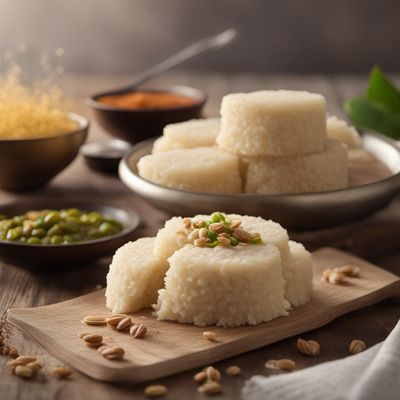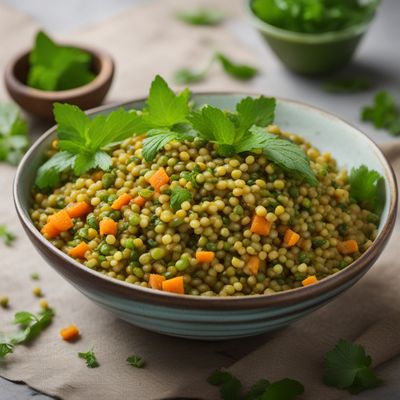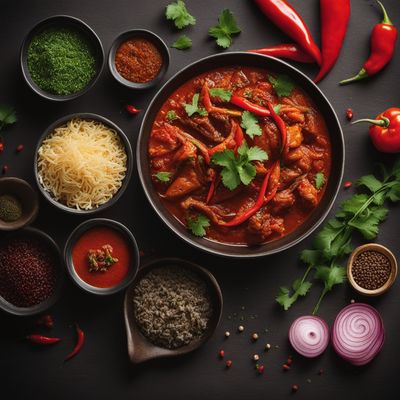
Recipe
Sanna with a Pakistani Chinese Twist
Spicy and Tangy Sanna: A Fusion Delight
4.6 out of 5
This recipe combines the traditional Indian dish, Sanna, with the bold flavors of Pakistani Chinese cuisine. The result is a mouthwatering fusion dish that combines the soft and fluffy texture of Sanna with the spicy and tangy flavors of Pakistani Chinese cuisine.
Metadata
Preparation time
20 minutes
Cooking time
15 minutes
Total time
35 minutes
Yields
4 servings
Preparation difficulty
Easy
Suitable for
Vegetarian, Vegan (if using vegan versions of soy sauce, chili sauce, and tomato ketchup), Gluten-free (if using gluten-free soy sauce and cornstarch), Dairy-free, Nut-free
Allergens
Soy (in soy sauce), Corn (in cornstarch)
Not suitable for
Paleo, Keto, Low-carb, High-protein, Mediterranean
Ingredients
In the original Indian cuisine, Sanna is typically served plain or with a coconut chutney. However, in this adapted Pakistani Chinese version, we incorporate a spicy and tangy sauce to give the Sanna a bold and flavorful twist. This adds a new dimension to the dish and makes it more suitable for those who enjoy spicy and tangy flavors. We alse have the original recipe for Sanna, so you can check it out.
-
2 cups (400g) rice flour 2 cups (400g) rice flour
-
1 cup (240ml) water 1 cup (240ml) water
-
1 teaspoon salt 1 teaspoon salt
-
1 teaspoon sugar 1 teaspoon sugar
-
1 teaspoon baking powder 1 teaspoon baking powder
-
1 tablespoon vegetable oil 1 tablespoon vegetable oil
-
1 tablespoon soy sauce 1 tablespoon soy sauce
-
1 tablespoon chili sauce 1 tablespoon chili sauce
-
1 tablespoon vinegar 1 tablespoon vinegar
-
1 tablespoon tomato ketchup 1 tablespoon tomato ketchup
-
1 tablespoon cornstarch 1 tablespoon cornstarch
-
1 tablespoon water 1 tablespoon water
-
2 tablespoons vegetable oil 2 tablespoons vegetable oil
-
1 onion, finely chopped 1 onion, finely chopped
-
1 bell pepper, thinly sliced 1 bell pepper, thinly sliced
-
1 carrot, thinly sliced 1 carrot, thinly sliced
-
1 cup (150g) cabbage, shredded 1 cup (150g) cabbage, shredded
-
2 cloves garlic, minced 2 cloves garlic, minced
-
1 teaspoon ginger, grated 1 teaspoon ginger, grated
-
Salt, to taste Salt, to taste
-
Black pepper, to taste Black pepper, to taste
-
Spring onions, for garnish Spring onions, for garnish
Nutrition
- Calories (kcal / KJ): 250 kcal / 1046 KJ
- Fat (total, saturated): 8g, 1g
- Carbohydrates (total, sugars): 40g, 4g
- Protein: 4g
- Fiber: 2g
- Salt: 1g
Preparation
-
1.In a large bowl, combine the rice flour, water, salt, sugar, and baking powder. Mix well to form a smooth batter.
-
2.Grease a steamer tray with vegetable oil and pour the batter into it. Steam the batter for about 15-20 minutes or until a toothpick inserted comes out clean. Set aside.
-
3.In a small bowl, mix together soy sauce, chili sauce, vinegar, tomato ketchup, cornstarch, and water. Set aside.
-
4.Heat vegetable oil in a wok or pan over medium heat. Add the chopped onion, bell pepper, carrot, cabbage, garlic, and ginger. Stir-fry for 2-3 minutes until the vegetables are slightly tender.
-
5.Pour the sauce mixture over the vegetables and stir well. Cook for another 2-3 minutes until the sauce thickens and coats the vegetables.
-
6.Cut the steamed Sanna into bite-sized pieces and add them to the wok. Gently toss the Sanna with the sauce and vegetables until well coated.
-
7.Season with salt and black pepper to taste. Cook for an additional 2 minutes to allow the flavors to meld together.
-
8.Garnish with spring onions and serve hot.
Treat your ingredients with care...
- Rice flour — Make sure to use fine rice flour for a smooth texture in the Sanna.
- Soy sauce — Use a good quality soy sauce for the best flavor.
- Chili sauce — Adjust the amount of chili sauce according to your spice preference.
- Tomato ketchup — Opt for a tangy and slightly sweet tomato ketchup for a balanced flavor.
- Cornstarch — Mix the cornstarch with water to create a slurry before adding it to the sauce to avoid lumps.
Tips & Tricks
- For a spicier version, add some red chili flakes or chopped green chilies to the sauce.
- Customize the vegetable selection according to your preference. You can add mushrooms, broccoli, or any other vegetables you enjoy.
- Serve the Sanna with a side of fried rice or noodles for a complete meal.
- If you prefer a milder flavor, reduce the amount of soy sauce and chili sauce in the sauce mixture.
- Garnish with freshly chopped cilantro for added freshness.
Serving advice
Serve the Spicy and Tangy Sanna as a main course dish with steamed rice or noodles. It can also be enjoyed as an appetizer or snack.
Presentation advice
Arrange the Sanna pieces on a serving platter and pour the sauce and vegetables over them. Garnish with spring onions for a pop of color. Serve hot to showcase the flavors and textures.
More recipes...
For Indian cuisine » Browse all
More Indian cuisine dishes » Browse all

Kadai paneer
Paneer and capsicum masala
Kadai paneer is a popular Indian dish made with paneer cheese and a variety of spices.

Bihari kebab
Bihari kebab is a spicy Indian dish made with marinated beef.

Khaja
Khaja is a popular Indian sweet that is made from flour, sugar, and ghee. It is typically served during festivals and special occasions, and is...








